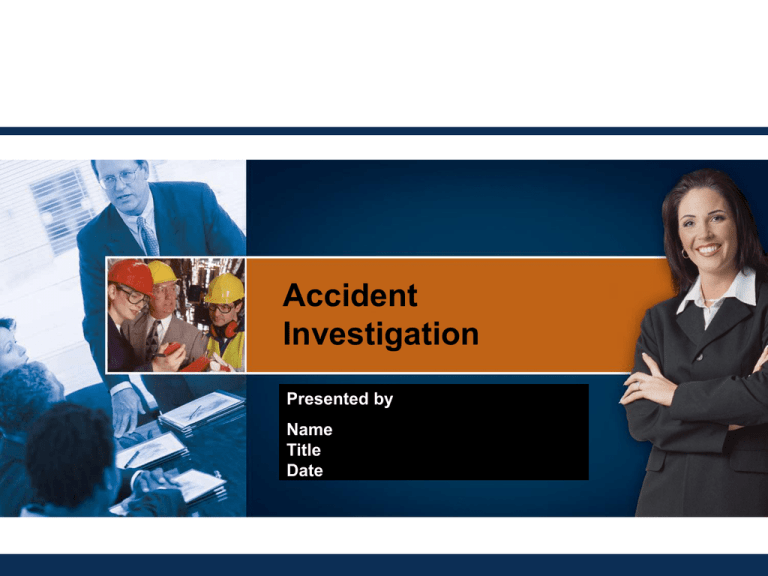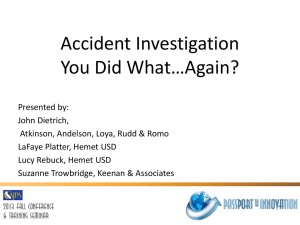Accident Investigation
advertisement

Accident Investigation Presented by Name Title Date Course Outline Four modules 1. Definitions 2. Causation 3. Investigations 4. Case study Workshop Objectives You will gain an understanding of • When to do a formal investigation • Immediate and fundamental causes • When to give notification of an accident • How to write a good accident report with recommendations Module 1 - Definitions • Accident • Incident • Accident Investigation Definition of Accident & Incident? Accident - Can be defined as an unplanned event that interrupts the completion of an activity, and that may (or may not) include injury or property damage. Incident - Usually refers to an unexpected event that did not cause injury or damage,but had the potential to do so. How does your workplace define these terms? What is an Accident Investigation? An accident investigation is a conscientious examination of all factors leading up to and included in an incident or accident… Why should we investigate? Reasons to investigate a workplace accident include: · most importantly, to find out the cause of accidents to prevent similar accidents in the future · to fulfill any legal requirements · to determine the cost of an accident · to determine compliance with applicable safety legislation · to process workers' compensation claims Module 2 - Finding the Causes • Immediate and basic • Accident statistics Finding the Causes Why are we having accidents? ? Immediate Causes Substandard Conditions • Inadequate protective equipment • Defective tools, equipment, materials • Poor housekeeping • Inadequate ventilation • Congested or restricted action Immediate Causes • • • • • • • Substandard Acts/Practices Operating equipment without authority Operating at improper speed Removing safety devices Failure to use PPE/warn/secure/follow procedures Horseplay Under influence of alcohol/drugs Improper loading/lifting/placement Basic Causes Personal Factors Inadequate physical/mental capability Lack of knowledge Lack of skill Stress Improper motivation Basic Causes Job Factors Wear and tear Inadequate: - Unclear/conflicting Abuse and misuse leadership Improper training - Engineering - Purchasing - Maintenance - Tools, equipment, materials - Work standards Accident Ratios 1 Serious 10 - Minor 30 - Property Damage 600 - Near Misses Report and investigate all accidents and incidents Iceberg Effect Accidents Cost Money $1 $5 to $50 Property Damage $1 to $3 Miscellaneous Insured Costs •Medical •Compensation Uninsured Costs •Building damage •Tool and equipment damage •Product and material damage • Hiring and training replacements • Investigation time Module 3 - Investigate • Reporting • Investigation procedures Committee may… • 15(j) participate in all inspections, inquiries and investigations concerning the health and safety of employees, and in particular the investigation of any matter referred to in section 43 • 15(i) investigate any complaint… Notices by Employers • 43(1) Injuries causing fatality, loss of limb or occupational disease, notify WorkSafeNB immediately. • 43(2) The employer shall immediately notify JHSC or representative. To report health and safety emergencies: 1 800 222-9775 Notices by Employers 43(3) No person shall disturb the scene, except (b) to prevent further injuries; or (c) to protect property that is endangered as a result of the accident. 43(4) An accidental explosion, or an accidental exposure, notify WorkSafeNB within 24 hours. To report exposures or explosions: 1 800 222-9775 Terms of Reference The size and scope of an investigation team as well as its purpose, duties and objectives should be clearly explained in the terms of reference or an investigation policy. Ensuring Accident Reporting • • • • Initial training - all incidents must be reported Encouragement - thank the individual Take immediate action on all reports Reinforce the importance of accident investigations whenever possible • Never place blame, as everyone is responsible Why Accidents May Not be Reported • Doesn’t want to be central person • ‘Spoils’ safety record • Fear/dislike of medical treatment • Afraid co-workers will ‘kid’ • Doesn’t like ‘red-tape’ • Afraid supervisor will be angry • Doesn’t want to lose time Purpose of an Accident Investigation It is to: • Find all causes • Prevent re-occurrence • Ensure due diligence at every level • Reduce accidents/costs • Show workers that management cares about h&s Purpose of an Accident Investigation It is not: • Filling out an accident report (Form 67, application for claim) • Fixing blame/finger pointing • To be conducted with a courtroom mentality Policy Every employer should have a written policy & procedure. The policy should include the following points: • All incidents/accidents will be investigated • Front line supervisor will conduct investigations • How recommendations will be applied and assessed • Employees are encouraged to report all incidents/accidents Procedures (Detailed) Steps to take when doing an incident investigation: 1. Encourage all staff to report incidents immediately 2. Examination of the situation by supervisory staff 3. Take immediate measures, if necessary 4. Refer to JHSC for follow-up Procedures (Detailed) Steps to take when doing an accident investigation: 1. 2. 3. 4. 5. Initial response activities Collect relevant information Analyze information Write report Follow up Supervisor as Accident Investigator •Two different viewpoints: ‘This is an opportunity to prevent the next accident.’ ‘This is unnecessary paperwork and an improper use, waste of my time’ Key Attributes of Competent Investigators • Assumes all accidents are preventable • Looks for many causes not just the first, most obvious cause • Be a good listener • Never attempts to find a culprit • Is as objective as possible • Always keeps the purpose of the investigation in mind Investigation Kit • • • • • • • • • Camera, film, and flash Tape measure Clipboard/pad Flashlight Pencils/pens Accident Investigation Form Investigation policy Chalk (yellow/white) Checklist Interview Techniques 1. Try to have private interviews 2. Put the person in the right frame of mind 3. Get their story in their own words 4. Probe for the full understanding 5. Conclude the interview on a positive note Questions to answer • Who? • What? • Where? • When? • Why? • How? Points to Remember • Be conscious of the feelings of others • Arrange for comfortable quarters in which to interview • Don’t jump to conclusions or pre-judge • Don’t let your personal bias take over • Never pass on information given to you in confidence by another party • Stick around after you have finished your formal investigation Investigation Report • The report should include the pertinent information collected from all sources, as well as the immediate and basic causes, and recommended actions to be taken • Should respect confidentiality • Recommendations should be concrete, precise, realistic and measurable Module 4 - Case Study • It is now time to investigate an accident Another Option • The group may prefer to investigate an accident that has already occurred at their workplace Summary During this session, you were made aware: • Of the difference between accident & incident • That root causes are the real reasons as to why accidents are occurring • That a proper investigation will reduce probability of accidents re-occurrence Effective accident investigations prevent physical injury, reduce costs, and contribute to the safety mindset of the workplace.








